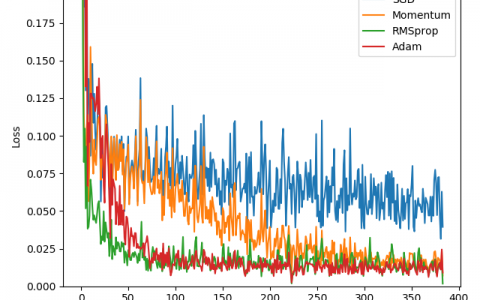PyTorch如何获得模型的计算量和参数量
在深度学习中,模型的计算量和参数量是两个重要的指标,可以帮助我们评估模型的复杂度和性能。在本文中,我们将介绍如何使用PyTorch来获得模型的计算量和参数量,并提供两个示例,分别是计算卷积神经网络的计算量和参数量。
计算卷积神经网络的计算量和参数量
以下是一个示例,展示如何计算卷积神经网络的计算量和参数量。
import torch
import torch.nn as nn
class Net(nn.Module):
def __init__(self):
super(Net, self).__init__()
self.conv1 = nn.Conv2d(3, 64, kernel_size=3, stride=1, padding=1)
self.conv2 = nn.Conv2d(64, 128, kernel_size=3, stride=1, padding=1)
self.conv3 = nn.Conv2d(128, 256, kernel_size=3, stride=1, padding=1)
self.fc1 = nn.Linear(256 * 4 * 4, 1024)
self.fc2 = nn.Linear(1024, 10)
def forward(self, x):
x = nn.functional.relu(self.conv1(x))
x = nn.functional.max_pool2d(x, 2)
x = nn.functional.relu(self.conv2(x))
x = nn.functional.max_pool2d(x, 2)
x = nn.functional.relu(self.conv3(x))
x = nn.functional.max_pool2d(x, 2)
x = x.view(-1, 256 * 4 * 4)
x = nn.functional.relu(self.fc1(x))
x = self.fc2(x)
return x
model = Net()
params = sum(p.numel() for p in model.parameters())
print(f'Number of parameters: {params}')
flops = torch.randn(1, 3, 32, 32)
flops = model(flops)
flops = int(2 * params * flops.size(0))
print(f'Number of FLOPs: {flops}')
在这个示例中,我们定义了一个简单的卷积神经网络模型,并使用sum(p.numel() for p in model.parameters())来计算模型的参数量。在计算模型的计算量时,我们首先生成一个随机的输入张量,并将其传递给模型。我们使用flops.size(0)来获取批量大小,并使用2 * params * flops.size(0)来计算模型的计算量。最后,我们打印出模型的参数量和计算量。
计算ResNet的计算量和参数量
以下是一个示例,展示如何计算ResNet的计算量和参数量。
import torch
import torch.nn as nn
class BasicBlock(nn.Module):
expansion = 1
def __init__(self, in_planes, planes, stride=1):
super(BasicBlock, self).__init__()
self.conv1 = nn.Conv2d(in_planes, planes, kernel_size=3, stride=stride, padding=1, bias=False)
self.bn1 = nn.BatchNorm2d(planes)
self.conv2 = nn.Conv2d(planes, planes, kernel_size=3, stride=1, padding=1, bias=False)
self.bn2 = nn.BatchNorm2d(planes)
self.shortcut = nn.Sequential()
if stride != 1 or in_planes != self.expansion*planes:
self.shortcut = nn.Sequential(
nn.Conv2d(in_planes, self.expansion*planes, kernel_size=1, stride=stride, bias=False),
nn.BatchNorm2d(self.expansion*planes)
)
def forward(self, x):
out = nn.functional.relu(self.bn1(self.conv1(x)))
out = self.bn2(self.conv2(out))
out += self.shortcut(x)
out = nn.functional.relu(out)
return out
class ResNet(nn.Module):
def __init__(self, block, num_blocks, num_classes=10):
super(ResNet, self).__init__()
self.in_planes = 64
self.conv1 = nn.Conv2d(3, 64, kernel_size=3, stride=1, padding=1, bias=False)
self.bn1 = nn.BatchNorm2d(64)
self.layer1 = self._make_layer(block, 64, num_blocks[0], stride=1)
self.layer2 = self._make_layer(block, 128, num_blocks[1], stride=2)
self.layer3 = self._make_layer(block, 256, num_blocks[2], stride=2)
self.layer4 = self._make_layer(block, 512, num_blocks[3], stride=2)
self.linear = nn.Linear(512*block.expansion, num_classes)
def _make_layer(self, block, planes, num_blocks, stride):
strides = [stride] + [1]*(num_blocks-1)
layers = []
for stride in strides:
layers.append(block(self.in_planes, planes, stride))
self.in_planes = planes * block.expansion
return nn.Sequential(*layers)
def forward(self, x):
out = nn.functional.relu(self.bn1(self.conv1(x)))
out = self.layer1(out)
out = self.layer2(out)
out = self.layer3(out)
out = self.layer4(out)
out = nn.functional.avg_pool2d(out, 4)
out = out.view(out.size(0), -1)
out = self.linear(out)
return out
def ResNet18():
return ResNet(BasicBlock, [2,2,2,2])
model = ResNet18()
params = sum(p.numel() for p in model.parameters())
print(f'Number of parameters: {params}')
flops = torch.randn(1, 3, 32, 32)
flops = model(flops)
flops = int(2 * params * flops.size(0))
print(f'Number of FLOPs: {flops}')
在这个示例中,我们定义了一个ResNet18模型,并使用sum(p.numel() for p in model.parameters())来计算模型的参数量。在计算模型的计算量时,我们首先生成一个随机的输入张量,并将其传递给模型。我们使用flops.size(0)来获取批量大小,并使用2 * params * flops.size(0)来计算模型的计算量。最后,我们打印出模型的参数量和计算量。
总结
本文介绍了如何使用PyTorch来获得模型的计算量和参数量,并提供了两个示例,分别是计算卷积神经网络的计算量和参数量以及计算ResNet的计算量和参数量。在实现过程中,我们使用了PyTorch和其他些库,并介绍了一些常用的函数和技术。
本站文章如无特殊说明,均为本站原创,如若转载,请注明出处:pytorch如何获得模型的计算量和参数量 - Python技术站

 微信扫一扫
微信扫一扫  支付宝扫一扫
支付宝扫一扫 

![[PyTorch 学习笔记] 2.2 图片预处理 transforms 模块机制](https://pythonjishu.com/wp-content/uploads/2023/04/EJuDGbexYxSj20230406.jpg)


